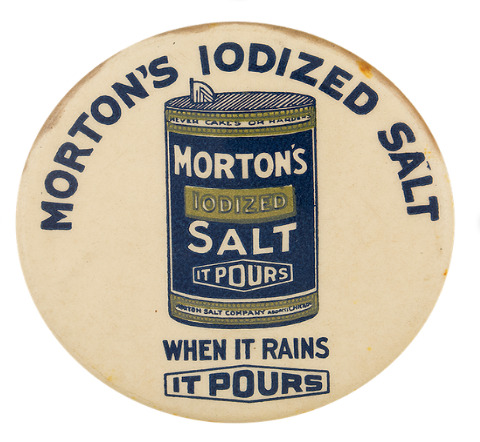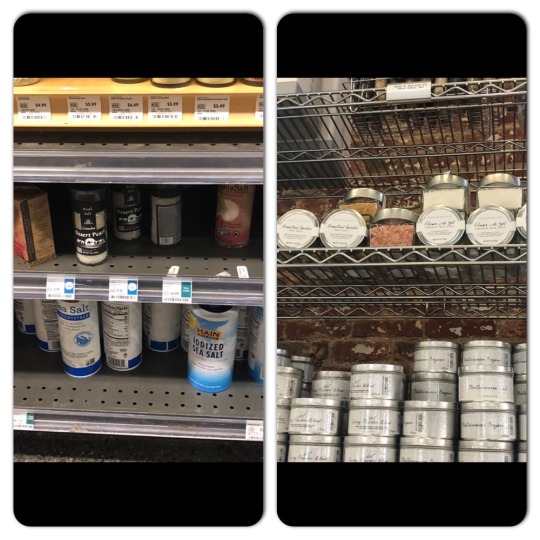#anth4000W
Text
Pink Salt: A Tale of Ethical Consumerism
Halite. NaCl. Sodium Chloride. All alternative ways to say “salt.”
When I think of salt, I am reminded of its not-so-subtle tang. It’s not a flavor, but more of a taste, or perhaps a “mouthfeel” as the fancy food connoisseurs might say. In my own cooking adventures, salt is always an afterthought. It’s not an ingredient that I add to my grocery list when shopping for supplies for a new recipe. Salt is simply the one food item that always sits in my pantry, as a bottle seems to last for years on end. And even though I often forget about its presence in my kitchen, it’s the one ingredient that is utterly, absolutely, and unequivocally vital to making food taste good.
Historical Significance
Beyond its ability to transform bland food into an exciting symphony of flavors, salt is a critical component of the human food system. According to food technology experts, salt is a popular food preservative because “its capacity to reduce water activity values…in foods slows down or even interrupts vital microbial processes” (Albarracin et al., 2010, p. 1330). Salt, in other words, extends the shelf life of packaged and canned food products by inhibiting bacterial growth and keeping food fresh.
Throughout history, salt has been essential to survival among people everywhere. It has been used to preserve meats and greens, allowing such foods to be consumed in cold winter months when hunting and foraging are difficult. In this sense, the usage of salt as a preservative enhances food security by ensuring that purchased items remain edible, thereby reducing food waste and safeguarding economic investments in groceries.
In addition to its success as a preservative, salt possesses numerous medicinal qualities. When cases of goiter—an “abnormal enlargement of your thyroid gland” often caused by iodine deficiency—spiked in the early 20th century, public health officials and medical doctors decided to add sodium iodide to salt in order to combat the epidemic (Mayo Clinic). Salt, in other words, was utilized as a vehicle for iodine delivery. In order to reverse the iodine deficiency, “iodized salt” appeared to be the “most practical” because “everyone used salt on a daily basis” (Markel, 221-223). Since iodized salt first appeared on grocery store shelves, the prevalence of goiter dropped dramatically. By infusing salt with medicinal and preventative properties, health officials enhanced salt’s significance in society.

Beyond its use in public health intervention, salt is an important cultural and religious symbol. According to anthropologist Iulian Moga, salt has been utilized by “the peoples of the Near East” as an “agent…in some incantations and magical or therapeutic rituals where…it acted as a purifying device by restoring potency” (2015, p. 21). In fact, salt has been so essential to mythology, economy, and symbolism that it was the subject of a 2015 conference in Romania, entitled “First International Congress on the Anthropology of Salt.”
Although salt may seem like a boring or banal ingredient to study, I chose it because of its abundance in nature and society. It’s difficult to quantify the numerous times humans interact with salt on a daily basis—through metaphors, food, skin care products, history (i.e. Salt Wars), and dozens of other areas, society is deeply intertwined with NaCl. Salt is not only a taste, but a theme in human life.
Now that I’ve surely piqued your interest in salt, I hope to shed some light on salt’s role in grocery stores in Northwest Washington, D.C. During spring 2019, I conducted optical research at five sites: Whole Foods, CVS, Trader Joe’s, Dean & DeLuca, and Safeway. During my data collection, I examined salt through an anthropological lens, which allowed me to analyze salt’s relationship to consumerism, culture, and economy. One limitation to my project is the methodology I used, as my research incorporates only optical observations, rather than interviews. Nonetheless, my project reveals important insights about local identities in Northwest D.C. and the social significance that salt carries.
Similarities
The placement of salt in stores across the five field sites was identical: salt was always in or adjacent to the spice aisle. Among the various seasonings, salt was never placed at eye level. At CVS and Dean & DeLuca, salt lived on the highest shelf, tucked away from the other ingredients. However, at Whole Foods, Trader Joe’s, and Safeway, salt was mostly congregated on the bottom shelf. Because all stores confined salt to the less popular—and more difficult to reach areas—I’ve determined that salt is not a “hot ticket” item.
From my research, I’ve concluded that grocery stores are organized in a way that prioritizes profit margins. Exciting and new items are always at eye level, as grocers want these goods to pop off the shelf and into a customer’s cart. Since salt is always tucked away, it seems as though stores do not intend to advertise these items. This relative neglect is likely due to the fact that salt is a shelf-stable commodity and a little goes a long way. Whereas consumers may want to try new types of produce, cereals, and beverages, salt is a mainstay item that lasts the test of time. It does not need to be replenished routinely, meaning that customers aren’t often buying salt on their weekly grocery trips.
In every store in my study, salt is near its soulmate: pepper. This dynamic duo stands close by on the shelf, as if grocers advertise it as a package deal. The relationship between the two seasonings likely relates to their importance in cooking, as both commodities are common ingredients in American recipes (if you don’t believe me, watch some cooking shows). In CVS, salt and pepper came in a twin pack, cementing their importance to one another.

(Top: Safeway, Left: Dean & DeLuca, Right: CVS)
As a final point of similarity, each store carried Himalayan Salt. Even CVS—a no frills sort of place—had several of its Himalayan pink salt jars in stock. Even though this sort of salt variety has become popular, it is certainly more expensive than the standard, run-of-the-mill kosher salt. As I will later discuss, the universal presence of pink salt in my data reveals salt’s dynamic social status and represents important trends in consumerism.
Differences
The greatest difference in the five stores I visited was variety. CVS offered the most limited selection, followed by Trader Joe’s. The small selection of salt at these markets was relative to the size of the spice sections, as both had the fewest varieties available. Surprisingly, Safeway had the most abundant selection, including sodium-free salt, boxed salt, and salt flakes. The second-best option for variety was Whole Foods which offered Celtic Sea Salt and a diverse set of packages. Although Dean & DeLuca had a modest selection of salt, its options were not the most gourmet or “bougie.” Even though Dean & DeLuca carried matcha salt, it lacked the salt flakes and imported varieties that Whole Foods and Safeway displayed.
The labeling at Dean & DeLuca was refined and homogenous. The salts were packaged in small glass and tin jars, with delicate labels in white, grey, and other natural tones. The lettering on these options was more ornate in comparison to the other stores. Trader Joe’s offered only salts of its own brand with labels that matched the store’s simple, effortless vibes.
Both Safeway and Whole Foods carried a wide variety of labeling and marketing strategies. These stores also had the most diverse price ranges for salt, with large boxes of kosher salt and small, fancy varieties. The cheapest salts were contained in cardboard packages with bright colors and large, clear typeface. In contrast to these ordinary varieties, the more expensive options came in glass jars and had refined colors and lettering. This broad variety is proportional to the size of the store, since Safeway and Whole Foods are both supermarkets, whereas the other stores are smaller grocers.
The orderliness and tidiness of the sections also widely varied. The salt selection at Whole Foods was badly arranged, as all options—especially the lower-priced ones—were poorly stocked. The labels faced the back of the shelf, and the entire selection looked uninviting. CVS was similarly unkempt, while the three other stores were beautifully organized. See Whole Foods on the left and Dean & DeLuca on the right:

Conclusions
My field work reveals a fascinating anthropology of salt, especially in regard to its social significance. From my five field sites, I found a clear dichotomy between craft salt and ordinary salt. Since the less expensive varieties were displayed closer to the floor at Whole Foods and Safeway, these grocers attempted to elevate the gourmet, artisanal items by bringing them closer to a customer’s eye level. Of course, the biggest surprise of my research was the universal prevalence of pink Himalayan salt.
In conducting my study, I’ve thought a lot about why Himalayan salt has such popularity. I realized that the packaging of pink salt does not advertise any health benefit or claim to be tastier than the standard salt varieties. The only explicit marketing tool utilized for pink salt was in Whole Foods, where the jar displayed an illustration of the snow-capped Himalayas.

Priced at $8.99, this jar’s depiction of mountains serves as an “imaginary” in its effort to portray the salt as natural, sustainable, and refined (Besky, 2013, e-book pg. 58). For just one dollar more, the same brand offered a “fair trade” version of the salt, adding to the image of ethical consumerism.
Because four of the five stores I visited did not advertise the pink salt as superior to the standard varieties, it is likely that shoppers in northwest D.C. carry
an implicit assumption that pink salt is high-quality. Included in this impression of quality is a belief that the item is healthier, more organic, and even more flavorful than non-craft options.
Grocery stores are aware of the social significance of items such as Himalayan salt and capitalize upon the “imaginary.” As such, Himalayan salt is an essential index of social status, as consumers in northwest D.C.—a wealthy area—likely associate it with green consumerism and healthy living. Such an association stems from social and cultural experiences, as the majority of stores did not promote the item in any way. The universal presence of pink salts speaks to the local identities of consumers, as well as trends in high-end stores that market craft items as superior to more industrialized goods.
Although salt is a basic commodity, its variation reflects cultural preferences and assumptions. My biggest takeaway from this field research: never underestimate the social significance of a material good.
-- Lauren Petersil
References
Albarracin, W., Sanchez, I., Grau, R., and Barat, J. (2010). Salt in food processing; usage and reduction: a review. International Journal of Food Science & Technology, 46 (7), 1329-1336.
Besky, S. (2013). The Darjeeling Distinction: Labor and Justice on Fair-trade Tea Plantations in India. Oakland: University of California Press.
Goiter (2018). Mayo Clinic. Retrieved from https://www.mayoclinic.org/diseases-conditions/goiter/symptoms-causes/syc-20351829
Markel, H. (1987). “When it Rains it Pours”: Endemic Goiter, Iodized Salt, and David Murray Cowie, MD. American Journal of Public Health 77 (2), 219-229.
Moga, I. (2015). Salt and Related Agents in Curse and Benediction Formulas of the Near East. In M. Alexianu, R.G. Curca, and V. Cotiuga (Ed.) From the ethno-archaeology to the anthropology of salt: programme and abstracts. Iasi, Romania: Editura Universitatii. Pg. 21.
Clayman, A. Morton Salt Company, est. 1848. (2019). Made in Chicago Museum. Retrieved from https://www.madeinchicagomuseum.com/single-post/morton-salt-co
#salt#NaCl#tablesalt#koshersalt#imaginary#saltflakes#pinksalt#bougie#boujee#safeway#wholefoods#wholepaycheck#cvs#deananddeluca#traderjoes#grocery#shopping#washingtondc#research#anth4000W#culture#anthropology#laurenpetersil
0 notes